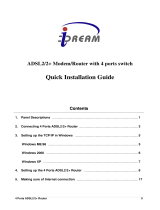
Table of Contents iii
WAN - Wide Area Network.................................................................................................................. 41
ISP .................................................................................................................................................. 41
DNS................................................................................................................................................ 51
ADSL.............................................................................................................................................. 52
System................................................................................................................................................. 54
Time Zone....................................................................................................................................... 54
Remote Access................................................................................................................................ 55
Firmware Upgrade.......................................................................................................................... 56
Backup / Restore............................................................................................................................. 57
Restart Router................................................................................................................................. 58
User Management........................................................................................................................... 59
Firewall and Access Control .............................................................................................................. 60
General Settings.............................................................................................................................. 61
Packet Filter.................................................................................................................................... 62
Intrusion Detection......................................................................................................................... 70
URL Filter....................................................................................................................................... 72
IM / P2P Blocking.......................................................................................................................... 74
Firewall Log ................................................................................................................................... 75
VPN - Virtual Private Networks (BiPAC 7404VGO Only)................................................................. 76
PPTP (Point-to-Point Tunneling Protocol)..................................................................................... 76
IPSec (IP Security Protocol)........................................................................................................... 84
L2TP (Layer Two Tunneling Protocol) .......................................................................................... 94
VoIP - Voice over Internet Protocol.................................................................................................. 107
Wizard........................................................................................................................................... 108
General Settings.............................................................................................................................110
Phone Port .....................................................................................................................................113
PSTN Dial Plan (Router with LINE port only).............................................................................115
VoIP Dial Plan ...............................................................................................................................118
Ring & Tone ................................................................................................................................. 123
Special Dial Codes ....................................................................................................................... 124
QoS - Quality of Service................................................................................................................... 125
Prioritization................................................................................................................................. 125
Outbound IP Throttling (LAN to WAN)....................................................................................... 127
Inbound IP Throttling (WAN to LAN)......................................................................................... 128
Virtual Server (known as Port Forwarding)..................................................................................... 132
Add Virtual Server........................................................................................................................ 133
Edit DMZ Host............................................................................................................................. 134
Edit DMZ Host............................................................................................................................. 135
Edit One-to-One NAT (Network Address Translation)................................................................ 136
Time Schedule................................................................................................................................... 139
Configuration of Time Schedule .................................................................................................. 140
Advanced .......................................................................................................................................... 141
Static Route................................................................................................................................... 141
Dynamic DNS .............................................................................................................................. 142
Check Email ................................................................................................................................. 143
Device Management..................................................................................................................... 144
IGMP............................................................................................................................................ 147
VLAN Bridge............................................................................................................................... 147
SAVE CONFIGURATION TO FLASH............................................................................................... 151
LOGOUT.............................................................................................................................................. 152
CHAPTER 5: TROUBLESHOOTING................................................................................................ 153
PROBLEMS STARTING UP THE ROUTER..................................................................................... 153
PROBLEMS WITH THE WAN INTERFACE .................................................................................... 153






















